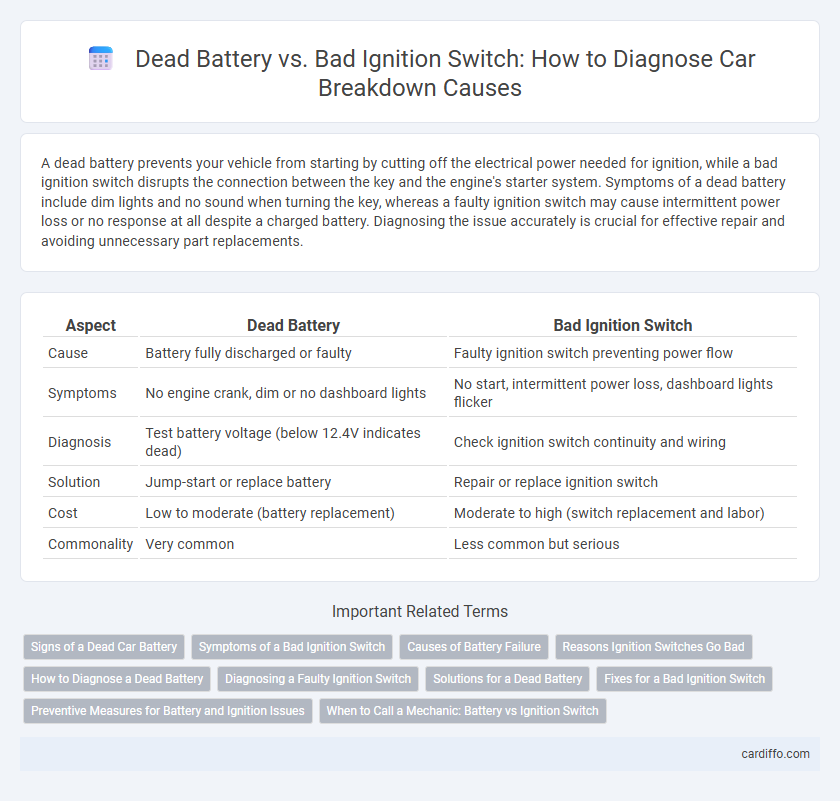A dead battery prevents your vehicle from starting by cutting off the electrical power needed for ignition, while a bad ignition switch disrupts the connection between the key and the engine's starter system. Symptoms of a dead battery include dim lights and no sound when turning the key, whereas a faulty ignition switch may cause intermittent power loss or no response at all despite a charged battery. Diagnosing the issue accurately is crucial for effective repair and avoiding unnecessary part replacements.
Table of Comparison
| Aspect | Dead Battery | Bad Ignition Switch |
|---|---|---|
| Cause | Battery fully discharged or faulty | Faulty ignition switch preventing power flow |
| Symptoms | No engine crank, dim or no dashboard lights | No start, intermittent power loss, dashboard lights flicker |
| Diagnosis | Test battery voltage (below 12.4V indicates dead) | Check ignition switch continuity and wiring |
| Solution | Jump-start or replace battery | Repair or replace ignition switch |
| Cost | Low to moderate (battery replacement) | Moderate to high (switch replacement and labor) |
| Commonality | Very common | Less common but serious |
Signs of a Dead Car Battery
Signs of a dead car battery include the engine failing to crank or turning over very slowly, dim or non-functional dashboard lights, and a complete absence of electrical power such as no radio or interior lights. Clicking sounds when turning the key often point to insufficient battery power to start the vehicle. Corroded battery terminals and a swollen battery case are physical indicators that the battery may be dead rather than an issue with the ignition switch.
Symptoms of a Bad Ignition Switch
Symptoms of a bad ignition switch include difficulty starting the vehicle, intermittent stalling while driving, and flickering dashboard lights. A faulty ignition switch can cause the engine to crank without starting or cut off power to essential systems, leading to unexpected breakdowns. Unlike a dead battery that results in no electrical power, ignition switch issues disrupt the connection between the key and the engine's electrical components.
Causes of Battery Failure
Battery failure commonly results from factors such as prolonged exposure to extreme temperatures, parasitic electrical drains, and age-related degradation of battery cells. Corroded or loose battery terminals and frequent short trips that prevent complete charging also contribute to diminished battery performance. Unlike a bad ignition switch, which disrupts electrical connections, battery failure originates primarily from internal chemical and structural issues within the battery itself.
Reasons Ignition Switches Go Bad
Ignition switches go bad due to worn internal contacts from frequent use, exposure to moisture causing corrosion, and electrical faults such as short circuits or voltage spikes. These issues prevent the switch from properly transmitting the necessary power to start the engine, often mimicking symptoms of a dead battery. Regular maintenance and timely replacement of aging ignition components can help avoid unexpected breakdowns caused by a failing ignition switch.
How to Diagnose a Dead Battery
To diagnose a dead battery, start by turning on the headlights; if they are dim or fail to illuminate, the battery is likely drained. Use a multimeter to check the battery voltage, which should read around 12.6 volts when fully charged and below 12 volts when discharged. Jump-start the vehicle or attempt to start the engine--if it powers on only with a jump, the battery is the primary issue, distinguishing it from ignition switch problems.
Diagnosing a Faulty Ignition Switch
A faulty ignition switch often mimics the symptoms of a dead battery, such as engine failure to start and dim dashboard lights, complicating accurate diagnosis. Testing the ignition switch involves checking for consistent voltage supply to the starter and accessory circuits when the key is turned, using a multimeter or circuit tester. Professional diagnostics may also include inspecting ignition cylinder wear and verifying electrical continuity to distinguish it from battery-related issues.
Solutions for a Dead Battery
Jump-starting a dead battery with jumper cables and a functioning vehicle is the fastest solution to get your car running again. If jump-starting fails, replacing the battery with a new, fully charged one is essential to ensure reliable starting power. Using a battery maintainer or charger can prevent future dead battery issues by keeping the battery at optimal charge levels.
Fixes for a Bad Ignition Switch
Fixes for a bad ignition switch involve diagnosing electrical continuity issues and repairing or replacing faulty components to restore proper power flow. Replacing the ignition switch typically requires disconnecting the battery, removing the steering column covers, and installing a new switch compatible with the vehicle's make and model. Professional automotive technicians recommend using high-quality replacement parts to prevent further breakdowns caused by ignition system failures.
Preventive Measures for Battery and Ignition Issues
Regularly inspect and maintain your car battery by checking for corrosion, ensuring tight connections, and testing voltage levels to prevent sudden breakdowns. Schedule routine ignition switch evaluations to detect wear or faulty contacts that could disrupt electrical flow and engine start-up. Using these preventive measures significantly reduces the risk of unexpected battery failure and ignition switch malfunctions on the road.
When to Call a Mechanic: Battery vs Ignition Switch
Call a mechanic immediately if your vehicle fails to start despite a fully charged battery, indicating a potential bad ignition switch. Dead battery symptoms include dim headlights and electrical issues, easily tested with a multimeter before seeking professional help. Ignoring a faulty ignition switch can lead to intermittent stalling or complete engine failure, necessitating timely expert diagnosis and repair.
Dead battery vs bad ignition switch Infographic

 cardiffo.com
cardiffo.com